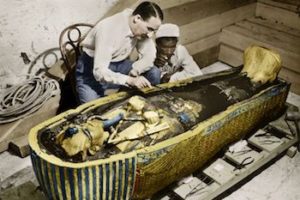
On this date in 1922, Black Egyptian King Tut’s tomb was discovered in Egypt by Howard Carter and Lord Carnarvon.
The burial place of King Tutankhamun (his full name) was hidden beneath the mud-brick houses of the workmen who cut the tomb of Ramesses VI. Presumably, this tomb was not carved for a king but for a high official. But because King Tut died early, the rooms were hurriedly converted. Items for the afterlife were placed in various rooms. This Pharaoh of Egypt’s find is important because the contents were untouched by thieves. The ancient artifacts can be found in the Cairo Museum.
Three coffins, the last made of solid gold, were found in the tomb. King Tut's mummy was not in very good shape and, as a result, was kept at his tomb. He had 15 rings of various sizes on his mummy fingers, depending on the linen used to wrap his hands. He also had 13 bracelets, assorted amulets, and earrings. Ancient Egyptians were Black Africans displaced by later movements of peoples, such as the Macedonian, Roman, and Arab conquests.
They also found among the treasures 415 statues of servants complete with baskets and tools (one for each day plus supervisors). The servants were to do the everyday jobs expected of the king in the afterlife. Large beds of gold leaf were found to prepare the body for embalming. Other symbols found with the king were the lion, hippo, and cow.
The only part of the complex that contained wall paintings was the Burial Chamber. One of the scenes (shown) depicts the Opening of the Mouth Ceremony, where the senses are restored to the deceased King Tutankhamun. In this case, the person performing this duty is Ay, who became the next pharaoh.